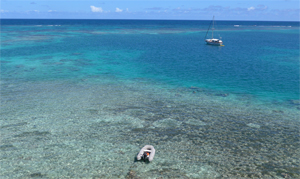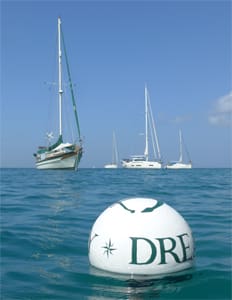One of the challenges of world voyaging is not only navigating open ocean, but also negotiating a busy anchorage when you finally arrive at your destination.
Eleven years ago in Makemo, our first anchorage in the Tuamotus — a remote chain of atolls that rests in the middle of the South Pacific — a pearl farmer allowed us to select a float from an impressive collection of weathered markers and buoys stacked on the sun-bleached coral on the edge of a dazzling turquoise lagoon. We chose an old fiberglass buoy about the size of a volleyball and asked how much we could pay him. It was a gift, he said with a smile, and welcomed us to French Polynesia.
Later that week, with our 1981 Cabo Rico Dream Time anchored alone in a lagoon — floating in water so absolutely clear a perfect shadow of the boat, even our kayak, could be seen resting on the sandy bottom 20 feet below the surface — we painted the buoy white and put a rusty can of green boottop paint to good use, branding our new float with an anchor on the top and “Dream Time NY” around its waterline.
Over the years and 46,000 nautical miles of world voyaging, my wife Catherine and I have deployed our Makemo marker in dozens of countries, and it has served us well — in the waters off Tonga, New Zealand, Fiji, Vanuatu, Australia, even Norfolk Island, Thailand, Turkey, Greece and Spain. And, as we have just crossed the Atlantic Ocean, sailing from Cape Verde to Saint Lucia, it now marks the location of our anchor in the Caribbean Sea. But unlike the deep anchorages we’ve visited where limestone ledges or volcanic rock threatened to snag our ground tackle, here we’re using it not to retrieve a fouled hook but to help secure a little room.
 |
|
The Hockleys' Cabo Rico 38, Dream Time, at anchor in Antigua with plenty of room. |
|
Neville Hockley |
When we left New York in 2007, we sailed south to the Panama Canal, exploring the quieter shorelines of Belize, Guatemala and Honduras, and along the way we shared anchorages with just a handful of boats. But this is our first time in the Eastern Caribbean, and space — particularly in the Leeward and Windward Islands — can be at a premium. Many of the popular bays surrounding Saint Lucia, Martinique, Antigua and the U.S. Virgin Islands are at capacity with thousands of cruising boats, charter catamarans and megayachts of all shapes and sizes squeezed together with barely any swing room to spare. But, even during the height of the sailing season, there are still plenty of anchorages with more than enough room to go around. Ironically, it’s when we find these quieter corners — locations not marked in the local cruising guide books — while anchored in shallow water with a sandy seabed that our Makemo marker has proven to be the most helpful.
Captains and charter yachts accustomed to anchoring in close quarters may not give a second thought to anchoring just off your bow, especially if they’ve just sailed over from English Harbour where a mere boat length between neighbors is standard practice. But if you don’t want a new neighbor quite so close, deploying an anchor marker can be a useful technique to securing a little room.
Anchor floats won’t work in crowded bays where space is limited and where boats lay and swing over each other’s hooks, but if there’s plenty of room to spare and you want new arrivals to know where your anchor is placed — especially if you’re on a full-keeled vessel that lays to current rather than wind — then an old fender over your hook can be a helpful marker to all.
We’re anchored now in Antigua, and while we may no longer have an entire lagoon all to ourselves, thanks to our Makemo marker at least we’ve secured a few boat lengths off our bow.
—Neville and Catherine Hockley sail aboard their Cabo Rico 38, Dream Time, and have just returned from a circumnavigation. To read more about Dream Time’s world voyage, visit www.zeroXTE.com.

